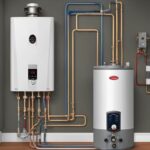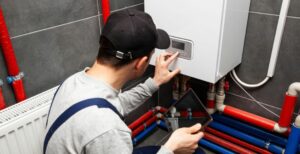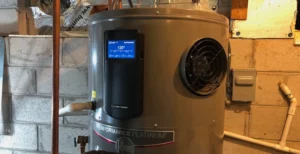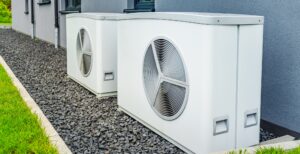Heating and air conditioning (HVAC) systems are crucial in maintaining comfort within our homes and workplaces.
But have you ever wondered what exactly HVAC means? HVAC stands for Heating, Ventilation, and Air Conditioning.
Its system keeps your indoor environment comfortable by regulating temperature, humidity, and air quality.
What Does HVAC Mean?

HVAC stands for Heating, Ventilation, and Air Conditioning. It’s a system that regulates temperature, humidity, and air quality to keep indoor environments comfortable.
Whether it’s keeping your home warm in the winter or excellent in the summer, types of HVAC systems play a crucial role in maintaining comfort and health.
Components of an HVAC System
An emergency HVAC system is made up of several components, each serving a specific function:
1. Air Conditioner: An air conditioner is a vital component of an HVAC system, especially in warmer climates.
It removes heat from indoor air and transfers it outside, effectively cooling the indoor environment.
Using a refrigeration cycle, the heating and air service conditioner cools the air by passing it over coils filled with refrigerant, thus creating a comfortable atmosphere indoors.
Regular air conditioner maintenance, including cleaning the coils and checking refrigerant levels, is essential to ensure optimal performance and energy efficiency.
2. Heat Pump: A heat pump is versatile and has heating and cooling capabilities.
It works by extracting heat from the outside air (even in colder temperatures) and transferring it indoors during winter while reversing the process to cool indoor spaces during summer.
Heat pump air conditioners offer energy-efficient heating and air conditioning service solutions, making them suitable for moderate climates.
However, proper sizing and installation are crucial to ensure maximum efficiency and performance.
3. Furnace: The furnace is responsible for heating the air in an HVAC system.
It burns fuel such as natural gas wall furnace, oil, or propane to generate heat distributed throughout the home via ductwork.
Furnaces are commonly used in colder climates where heating is a primary concern.
Regular maintenance, including cleaning or replacing air filters and inspecting the ignition system, is essential for ensuring the furnace operates safely and efficiently.
4. Air Handler: The air handler is a crucial component that circulates conditioned air throughout the home.
It includes a blower fan and an evaporator coil, which distribute heated or cooled air through the ductwork system.
The air handler is typically indoors in a utility closet, attic, or basement. Proper air handler maintenance, such as cleaning or replacing filters and lubricating moving parts, helps ensure efficient operation and optimal indoor air quality.
5. Ductwork: Ductwork is the network of tubes or channels that distribute air throughout the home.
It carries heated or cooled air from the furnace, heat pump, or air conditioner to different rooms, ensuring even temperature distribution and comfort.
Adequately designed and sealed ductwork is essential for maximizing HVAC system efficiency and minimizing energy loss.
By regularly inspecting and cleaning your ductwork, you safeguard against leaks and blockages and ensure healthier indoor air quality, providing lasting comfort.
6. Thermostat: The thermostat serves as the control center of the HVAC system, allowing users to set and regulate the indoor temperature.
Modern thermostats often come with programmable features, allowing for energy-efficient temperature adjustments throughout the day.
Some thermostats also offer remote access and smart technology capabilities, enabling users to control their HVAC technician system from anywhere using a smartphone or other devices.
Proper programming and calibration of the thermostat are essential for ensuring accurate temperature control and maximizing energy savings.
Regular maintenance, such as replacing batteries and cleaning the thermostat, can help prevent malfunctions and ensure reliable operation.
For homes with infloor heating systems, additional considerations may apply to ensure compatibility and optimal performance within the HVAC system.
How Does an HVAC System Work?

1. Air Intake: The HVAC system begins by drawing air from either the outside environment or recirculating indoor air.
This intake process is crucial as it determines the quality of air that will be conditioned and distributed throughout the building.
Outdoor air may contain pollutants, allergens, or other contaminants that must be filtered to maintain clean indoor air quality.
On the other hand, recirculating indoor air allows the reuse of already conditioned air, which can be more energy-efficient but may require proper filtration to remove any accumulated pollutants or particles.
2. Ventilation: Once the air is drawn into the HVAC system, it undergoes a ventilation process where it is filtered and purified.
Ventilation removes contaminants such as dust, pollen, mold spores, and other airborne particles, ensuring indoor air quality remains clean and healthy.
Filters within the system capture these pollutants, preventing them from circulating back into the living spaces.
Proper ventilation is essential for maintaining comfort, promoting respiratory health, and reducing the risk of allergies and respiratory illnesses caused by poor indoor air quality.
3. Heating or Cooling: Depending on the desired indoor temperature, the HVAC system activates heating or cooling components to adjust the air temperature accordingly.
In colder weather, the heating system generates heat to warm the air, typically a furnace or heat pump. Furnaces use combustion of fuel sources like natural gas, oil, or propane, while heat pumps extract heat from the outdoor air and transfer it indoors.
Conversely, during hotter months, the cooling system, usually an air conditioner or heat pump, removes heat from indoor air, cooling it down before circulating it back into the living spaces.
This heating or cooling process is essential for maintaining comfort and regulating indoor temperature throughout the year.
4. Air Distribution: Once conditioned, the air is distributed throughout the building via a network of ductwork.
The air handler, an HVAC system working principle component, is crucial in circulating the conditioned air through the ducts to reach different rooms and areas within the building.
The air handler contains a blower fan, which forces the air through the ductwork, and an evaporator coil, which helps cool or heat the air as needed.
Proper air distribution ensures that every part of the building receives adequate heating or cooling, maintaining consistent comfort levels throughout the indoor spaces.
5. Temperature Regulation: The thermostat serves as the control center of the HVAC system, allowing users to set and regulate the indoor temperature according to their preferences.
Modern thermostats often feature programmable settings, enabling users to schedule temperature adjustments throughout the day for energy efficiency and convenience.
The thermostat accurately senses the indoor temperature and activates the heating or cooling components as needed, helping maintain a comfortable and consistent temperature level within the building.
Proper temperature regulation enhances comfort and contributes to energy savings by avoiding unnecessary heating or cooling when it’s superfluous, ultimately reducing utility costs and environmental impact.
6. Humidity Control: In addition to regulating temperature, HVAC systems help control indoor humidity levels for optimal comfort and health.
In humid climates, the system removes excess moisture from the air through condensation or dehumidification, preventing mold growth, musty odors, and discomfort.
Conversely, in dry climates or during winter, when indoor air tends to be dry, the HVAC system may add moisture to the air through humidification, preventing issues like dry skin, static electricity, and respiratory irritation.
By maintaining balanced humidity levels, the HVAC system creates a more comfortable and healthy indoor environment for occupants throughout the year.
Some HVAC systems may integrate with gas hot water tanks to efficiently provide heating and domestic hot water needs.
What HVAC System Is Right for Me?
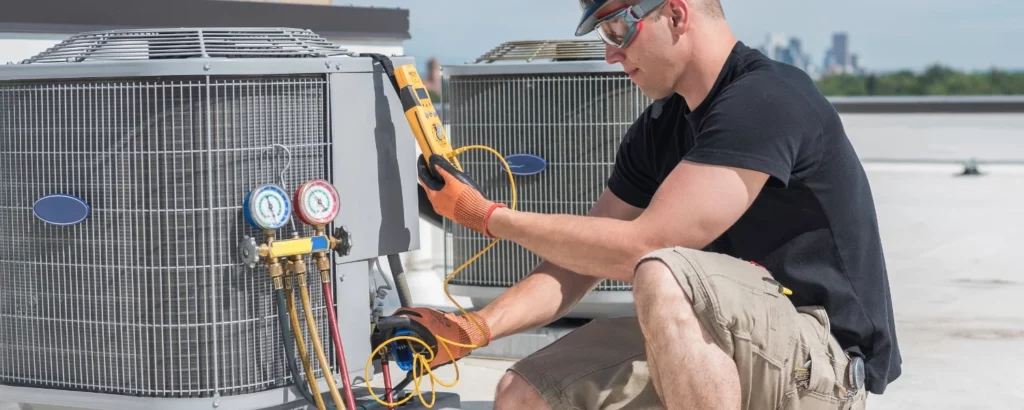
Choosing the right HVAC system depends on your home’s size and layout, climate, and budget. Some standard HVAC systems include:
1. Central Air Conditioning: Central air conditioning systems are suitable for larger homes where consistent cooling throughout the house is necessary.
These systems use ductwork to distribute cooled air efficiently to every room.
They offer excellent cooling performance and can be integrated with heating systems for year-round comfort. However, installation can be more complex and costly, especially if ductwork needs to be installed or upgraded.
2. Ductless Mini-Split: Ductless mini-split systems are ideal for smaller spaces or homes without existing ductwork.
They consist of an outdoor compressor unit and one or more indoor air-handling units connected by refrigerant lines.
These systems offer targeted heating and cooling, allowing you to set different temperatures for individual rooms or zones.
They are energy-efficient, easy to install, and provide flexibility in room-by-room temperature control.
3. Heat Pump System: Heat pump systems are versatile options providing heating and cooling capabilities in one unit.
Depending on the season, they work by transferring heat indoors and outdoors.
Heat pumps are highly efficient in moderate climates but may require a supplemental heating source in colder regions.
They are cost-effective regarding energy consumption and offer consistent comfort throughout the year.
4. Geothermal Heat Pump: Geothermal heat pumps utilize the ground’s stable temperature to provide heating and cooling for your home.
They are highly efficient and environmentally friendly, as they harness renewable energy from the earth. While geothermal systems have higher upfront costs, they offer significant long-term savings on energy bills and reduce greenhouse electric hot water tank vs gas emissions.
They require sufficient space for installation and are best suited for homeowners committed to sustainability.
5. Dual Fuel System: Dual fuel systems combine a heat pump with a furnace, offering flexibility and energy efficiency in varying climates.
They automatically switch between the heat pump and the furnace based on outdoor temperatures, optimizing performance and minimizing energy consumption.
Dual fuel systems are ideal for regions with fluctuating weather conditions, where a heat pump may struggle to maintain efficiency in extreme cold.
They provide reliable heating and cooling year-round, ensuring comfort regardless of the weather.
Conclusion
Regular maintenance is essential for keeping your Heating and air conditioning process system running smoothly.
By understanding the components of your HVAC system and how they work together, you can ensure optimal performance and comfort in your home or workplace.
Whether you need a new system or are looking to maintain an existing one, prioritizing HVAC maintenance will help extend the lifespan of your equipment and save you money in the long run.



